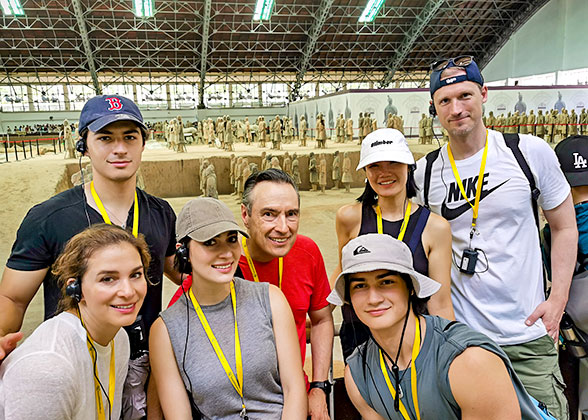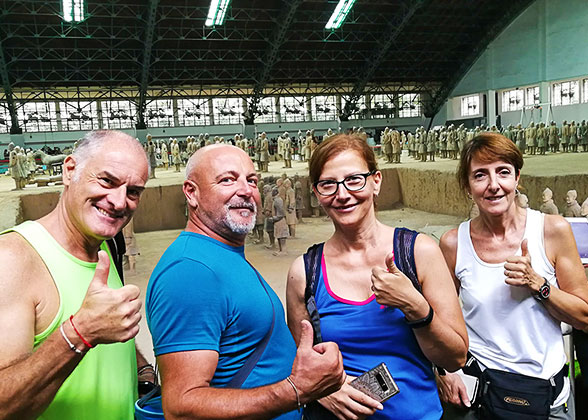Xi'an Private City Tour of Museums
Bell and Drum Towers - Forest of Stone Steles Museum - Banpo Museum - Shaanxi History Museum - Big Wild Goose Pagoda
From USD99 per person Book
- Itinerary
- Prices
- Reviews
Trip Highlights
- Appreciate ancient Chinese calligraphy, stone carving art, and cultural fusion at Forest of Stone Steles Museum.
- Delve into the matrilineal Yangshao Culture - a great piece of prehistorical civilization - from 6,000 years ago at Banpo Museum.
- Travel back in time at Shaanxi History Museum, a timewarp to witness countless ancient relics dating to Stone Age.
- Revel in rich Tang era-themed cultural prosperity in Great Tang All Day Mall.
- No commission-based shopping stops! More time will be spent on attractions and you will enjoy a pure sightseeing tour.
- No optional tours! Optional tour is just a tourist trap and will always cost you more with a high markup on price.
This trip can be customized to meet your individual needs!
Start your one-day Xi'an city tour at around 09:00 am, when your private guide and driver will meet you at your hotel. First, go for a photo stop at Bell and Drum Towers Square. Morning is one of the best times to take photos of the two ancient towers with golden sunlight. Especially the bell tower of the Ming Dynasty (1368-1644), such a landmark that draws every traveler to pose before it for photographs.
After that, we will head to the Forest of Stone Steles Museum, also known as Beilin Museum. Seven major showrooms with a collection of ancient stone tablets, epitaphs, and stone carvings spanning nearly a millennium among more than 11,000 cultural relics await you to explore. With our guide, linger for a longer time before the precious Nestorian Stele, as world-famous as the Rosetta Stele in the British Museum and the Moabite Stele in the Louvre Paris. The giant Stele, on which you can find a text of 1,780 Chinese characters with lines in Syrian, is the earliest witness of Christianity being introduced into China from Syria during the Tang Dynasty (618 - 907). But the key highlight would be the Six Steed of Zhao Mausoleum in the Stone Sculpture Art Gallery.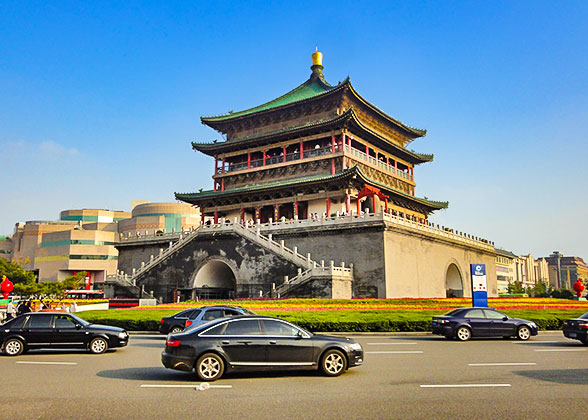
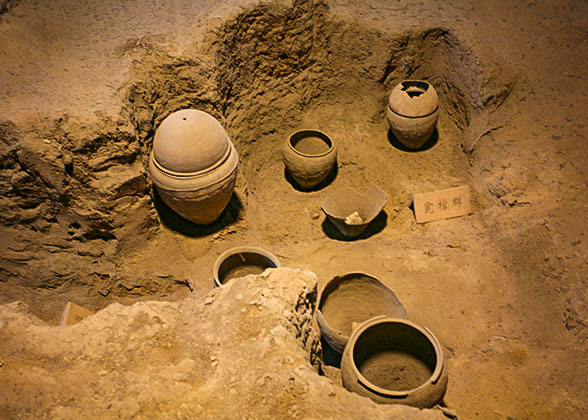 ★ Highlight in Forest of Stone Steles: Six Steeds of Zhao Mausoleum
★ Highlight in Forest of Stone Steles: Six Steeds of Zhao Mausoleum
You will have a great time appreciating the world-famous Six Steeds of Zhao Mausoleum, which refers to the relief sculptures of six horses that helped Emperor Taizong, the second emperor of the Tang Dynasty (618 - 907), during battles. These statues depict vivid scenes of horses galloping. What you will see here actually are four originals and two replicas as the other two authentic pieces are now stored abroad in the Penn Museum in USA. These stone carvings were first globally noticed around 1907, when a French sinologist discovered them in a deserted land in Shaanxi Province. Then he published several photos of them in French newspapers, which aroused the attention of some cultural relics dealers, who then came to China to take them away but failed due to the intervention of local government. Later, two of these horses were transported overseas by China’s then most notorious cultural relics dealer and were purchased by the Penn Museum for USD 125,000 with alumni funding. Just to give you an idea, this amount of money could buy a royal mansion located in the most bustling area in Beijing at that time.
► Tip from Our Expert: The Forest of Stone Steles Museum offers a profound cultural experience, but its numerous stone tablets might be monotonous or overwhelming for some, particularly younger travelers or those seeking a more dynamic itinerary. If you prefer a more varied experience, the ancient Xi'an City Wall and the Great Mosque are good choices. Any part of the itinerary can be customized to suit your specific interests. Just feel free to contact our travel consultants.
A visit follows to the Banpo Museum, where we will learn about the matriarchal clan of Yangshao Culture flourished during the Neolithic period about 6,000 years ago. As your guide commentates on some of thousands of prehistoric relics stored here, you will be taken back to the ancient society to witness Banpo people’s social structure, agriculture, social customs and daily life. We will explore for primitive village ruins, observe farming tools and living supplies made of stone, bone and pottery, and more. An exemplar is a painted pottery basin with human face and fish patterns, which would give you a glimpse into the fishing and hunting life of Banpo people. Also be amazed at a pottery fragment, which has applied geometry art on it telling the abstract aesthetics of the people.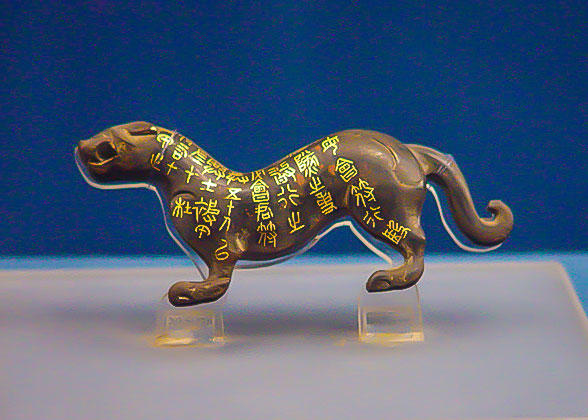
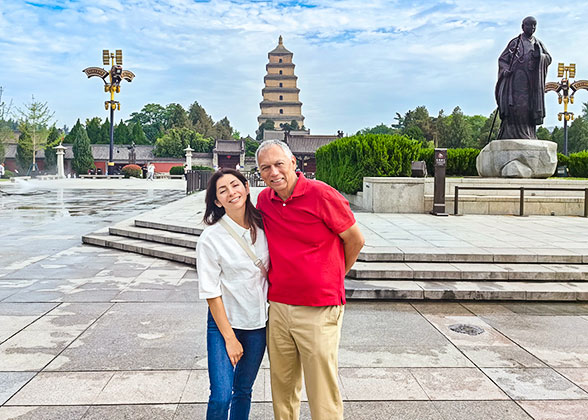 Lunch is on your own arrangement and your guide is pleased to assist. Bang Biang Noodles or Crumbled Flatbread in Mutton Stew is recommended for a try. Local food specialties will add to your trip a delicious experience!
Lunch is on your own arrangement and your guide is pleased to assist. Bang Biang Noodles or Crumbled Flatbread in Mutton Stew is recommended for a try. Local food specialties will add to your trip a delicious experience!
In the afternoon, continue the trip to the Shaanxi History Museum to learn more about the profound Chinese civilization. There is a collection of more than 1.7 million cultural relics from the Stone Age to about 1840. Among these, your guide will give you insights on all the highlights including exquisite bronze vessels of the Shang and Zhou Dynasties (1600 - 256 BC), terracotta warriors from Qin Shi Huang’s mausoleum, delicate gold and silver ware, and gorgeous mural paintings of the Han (202 - 220 BC) and Tang Dynasties. Especially examine the Bronze Tiger-Shaped Tally of Du County, which was a small token to mobilize armies in the Qin Dynasty (221 - 207 BC). It was created in half: the right half was held by the Qin emperor and the left half by a general - only when the two halves fitted together can over 50 soldiers be dispatched.
Then stop by Giant Wild Goose Pagoda, the earliest and largest square brick tower built during the Tang Dynasty to store Buddhist texts from India, and appreciate it from a distance. You will also have some free time to explore the nearby Great Tang All Day Mall, a long prosperous pedestrian street, for a full immersion in the Tang Dynasty culture. Stroll past young people dressed up as ancient people and under lines from Chinese poetry and red lanterns hung on the trees, visit souvenir kiosks that interest you, and when the night falls, encounter cultural performances. Late into afternoon, we will drive you back to the hotel, unless you want to eat here and roam till late to admire the beautiful lighting and antique architecture complementing each other, and then take a cab back on your own.
► Restaurant Recommendation for Dinner (at your own expense):
For dinner, you can walk about ten minutes to Tang Dynasty Cat Courtyard Night Banquet Chang'An. Your guide will be glad to help you to locate it. The overall taste of their dishes are highly praised, mainly Shaanxi dishes such as gourd-shaped chicken and barbecue. This restaurant is not only traditionally decorated, but draws with an innovative characteristic element: an image of a lovely instgrammable fat cat in Tang suit. Also, it offers various seating options - you can dine inside or out in the courtyard or taste tea on the second floor. After eating, maybe pay to experience the fans painting, a Chinese intangible cultural heritage.
Average cost per person: CNY 80 (USD 11)
Address: No. B7, Zone A, Great Tang All Day Mall, Ci'en East Road, Yanta District
After that, we will head to the Forest of Stone Steles Museum, also known as Beilin Museum. Seven major showrooms with a collection of ancient stone tablets, epitaphs, and stone carvings spanning nearly a millennium among more than 11,000 cultural relics await you to explore. With our guide, linger for a longer time before the precious Nestorian Stele, as world-famous as the Rosetta Stele in the British Museum and the Moabite Stele in the Louvre Paris. The giant Stele, on which you can find a text of 1,780 Chinese characters with lines in Syrian, is the earliest witness of Christianity being introduced into China from Syria during the Tang Dynasty (618 - 907). But the key highlight would be the Six Steed of Zhao Mausoleum in the Stone Sculpture Art Gallery.

Bell Tower of Xi'an

Banpo Museum
You will have a great time appreciating the world-famous Six Steeds of Zhao Mausoleum, which refers to the relief sculptures of six horses that helped Emperor Taizong, the second emperor of the Tang Dynasty (618 - 907), during battles. These statues depict vivid scenes of horses galloping. What you will see here actually are four originals and two replicas as the other two authentic pieces are now stored abroad in the Penn Museum in USA. These stone carvings were first globally noticed around 1907, when a French sinologist discovered them in a deserted land in Shaanxi Province. Then he published several photos of them in French newspapers, which aroused the attention of some cultural relics dealers, who then came to China to take them away but failed due to the intervention of local government. Later, two of these horses were transported overseas by China’s then most notorious cultural relics dealer and were purchased by the Penn Museum for USD 125,000 with alumni funding. Just to give you an idea, this amount of money could buy a royal mansion located in the most bustling area in Beijing at that time.
► Tip from Our Expert: The Forest of Stone Steles Museum offers a profound cultural experience, but its numerous stone tablets might be monotonous or overwhelming for some, particularly younger travelers or those seeking a more dynamic itinerary. If you prefer a more varied experience, the ancient Xi'an City Wall and the Great Mosque are good choices. Any part of the itinerary can be customized to suit your specific interests. Just feel free to contact our travel consultants.
A visit follows to the Banpo Museum, where we will learn about the matriarchal clan of Yangshao Culture flourished during the Neolithic period about 6,000 years ago. As your guide commentates on some of thousands of prehistoric relics stored here, you will be taken back to the ancient society to witness Banpo people’s social structure, agriculture, social customs and daily life. We will explore for primitive village ruins, observe farming tools and living supplies made of stone, bone and pottery, and more. An exemplar is a painted pottery basin with human face and fish patterns, which would give you a glimpse into the fishing and hunting life of Banpo people. Also be amazed at a pottery fragment, which has applied geometry art on it telling the abstract aesthetics of the people.

Bronze Tiger-shaped Tally

Our Guests at Giant Wild Goose Pagoda
In the afternoon, continue the trip to the Shaanxi History Museum to learn more about the profound Chinese civilization. There is a collection of more than 1.7 million cultural relics from the Stone Age to about 1840. Among these, your guide will give you insights on all the highlights including exquisite bronze vessels of the Shang and Zhou Dynasties (1600 - 256 BC), terracotta warriors from Qin Shi Huang’s mausoleum, delicate gold and silver ware, and gorgeous mural paintings of the Han (202 - 220 BC) and Tang Dynasties. Especially examine the Bronze Tiger-Shaped Tally of Du County, which was a small token to mobilize armies in the Qin Dynasty (221 - 207 BC). It was created in half: the right half was held by the Qin emperor and the left half by a general - only when the two halves fitted together can over 50 soldiers be dispatched.
Then stop by Giant Wild Goose Pagoda, the earliest and largest square brick tower built during the Tang Dynasty to store Buddhist texts from India, and appreciate it from a distance. You will also have some free time to explore the nearby Great Tang All Day Mall, a long prosperous pedestrian street, for a full immersion in the Tang Dynasty culture. Stroll past young people dressed up as ancient people and under lines from Chinese poetry and red lanterns hung on the trees, visit souvenir kiosks that interest you, and when the night falls, encounter cultural performances. Late into afternoon, we will drive you back to the hotel, unless you want to eat here and roam till late to admire the beautiful lighting and antique architecture complementing each other, and then take a cab back on your own.
► Restaurant Recommendation for Dinner (at your own expense):
For dinner, you can walk about ten minutes to Tang Dynasty Cat Courtyard Night Banquet Chang'An. Your guide will be glad to help you to locate it. The overall taste of their dishes are highly praised, mainly Shaanxi dishes such as gourd-shaped chicken and barbecue. This restaurant is not only traditionally decorated, but draws with an innovative characteristic element: an image of a lovely instgrammable fat cat in Tang suit. Also, it offers various seating options - you can dine inside or out in the courtyard or taste tea on the second floor. After eating, maybe pay to experience the fans painting, a Chinese intangible cultural heritage.
Average cost per person: CNY 80 (USD 11)
Address: No. B7, Zone A, Great Tang All Day Mall, Ci'en East Road, Yanta District
Tour Prices
| 1 traveler | 2-3 travelers | 4-5 travelers |
|---|---|---|
USD229 | USD139 | USD99 |
- Prices are per person on twin sharing basis.
Price Includes
- Private English-speaking guide
- Private driver & air-conditioned vehicle
- Entrance fees to tourist sites
Price Excludes
- Hotel accommodation with breakfasts
- Lunches and dinners
- Gratuities to guide and driver
Itineraries you may also like:
